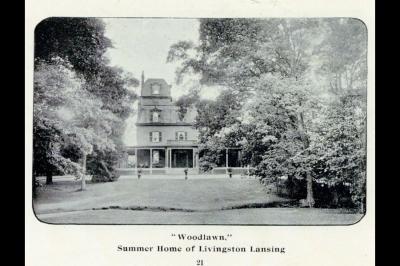This story is one in a series about the history of the Rand Estate, about 35 acres of land lying behind the stone wall on John and Charlotte streets, along the Heritage Trail and whose eastern boundary is a hedge between the properties at 176 and 210 John St.
Elizabeth Masson
Special to The Lake Report
No other estate in Niagara-on-the-Lake has been owned by so many famous personages as that of Randwood on John Street.
The land upon which today’s Rand Estate sits was originally part of a 160-acre tract granted to Peter Russell in 1796. Russell was receiver general and a member of the executive council of Upper Canada.
He and his half-sister Elizabeth built a comfortable house on a small farm located in the middle of today’s Commons. That house is believed to be the foundation of the hospital attached to Fort George, which one can see on the Commons today.
Russell, forced to move to York when Simcoe decided it would take the place of Niagara as the capital of Upper Canada, sold his Crown grant in August 1798 to William Dickson.
Dickson, from Dumfries, Scotland had been recruited by his cousin Robert Hamilton, the founder of Queenston, to join him in his business ventures in Canada. Dickson’s first house, at King and Prideaux streets., was the first one in the province to be made of brick. Dickson, who became one of Upper Canada’s first lawyers, married Charlotte Adlam, who had come to Niagara as governess to another member of the executive council, William Jarvis.
In 1811, on the part of Russell’s Crown grant which is now John Street, Dickson then built a large house with a library holding 1,000 books. In May of 1813, the invading Americans took him prisoner and along with a number of other prominent Niagarans, he was sent to East Greenbush, N.Y., near Albany.
On Dec. 10, 1813, when the town of Niagara was burned by the retreating Americans, Dickson’s house is said to have been the first one torched. It was burned, not by the regular American army soldiers, but by the Canadian Volunteers, under the command of Joseph Willcocks.
Willcocks was a distant relative of Peter Russell and had stayed with Russell and his sister (to whom he made “amorous advances”) when he first moved to Niagara from Ireland.
The targeted burning was because Dickson had fought a duel and killed a friend of Willcocks’ in New York state in 1806; duelling was illegal in Upper Canada then. The duel occurred near Fort Niagara at 7 a.m.
The two men counted off 10 paces, turned and fired almost simultaneously. His opponent, a Mr. Weekes, missed but Dickson’s ball went through Weekes’s body and he died the next day.
Dickson’s wife Charlotte was ill at the time the town was burned and was carried outside in her bed where she watched the house burn down on a bitterly cold December night. Charlotte Street is named after her.
Following the War of 1812, Dickson gave a portion of his land to the town to build a courthouse on what is now Rye Street, sold off other sections, and then divided the remainder between his two oldest sons, giving each about 500 feet of frontage on John Street.
William Dickson then moved to Galt (now Cambridge) and developed his land holdings there. He returned to Niagara in 1836 to live out the “remnant” of his life.
Of interest is the fact that Langdon Hall, the Relais & Chateaux property in Cambridge, Ont., was built by William Dickson’s great-granddaughter and the great-grandson of John Jacob Astor.
The eastern portion of Dickson’s John Street property went to son William who in turn sold it to Capt. Robert Melville, president of the Niagara Harbor and Dock Company. Melville built Brunswick Place, which stands today at 210 John St. Son Robert Dickson built the present brick house at 176 John St. in 1822 on the foundation of his father’s house; he named it Woodlawn.
In 1873, William Dickson’s youngest son Walter sold Woodlawn for $18,000 to American Civil War Gen. Henry Lansing; he was at that time, the secretary-treasurer of the Buffalo and Erie Railroad. Lansing added the third floor, the mansard roof, and an enclosed tower which the Rands later opened up.
While Lansing visited Niagara only in the summer, his sons Livingston and Watts, settled permanently in town and both were buried at St. Mark’s.
Watts Lansing built three houses in town, two of which are still standing: one opposite the Charles Inn on Queen Street is currently owned by developer Rainer Hummel. The other, opposite the golf course at 284 Queen St., was lived in by his daughter Sara who died in 1974 at age 87.
In 1910, the Lansings sold their property on John Street to George Rand, who was a self-made millionaire and the chair of Marine Trust Co. of Buffalo.
* Elizabeth (Betsy) Masson has been a research volunteer at the Niagara-on-the-lake Museum for more than 15 years.










